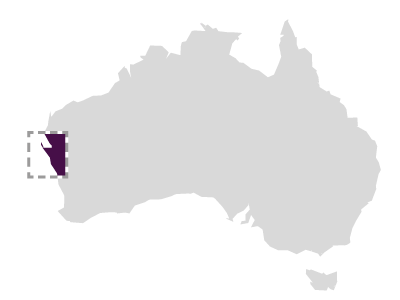Venus (1851/04/10)
Abrolhos, Southern Group

Tonnage: 21, later increased to 28
Captain John Thomas built the Venus as a cutter in 1839. Built of jarrah it was coppered three years later, and lengthened and re-rigged as a schooner in August 1850, just prior to its last voyage north. There is a sail plan of a cutter that has been passed down through the Thomas family and it has been conjectured that this is a plan of the Venus. The plan shows a vessel about 35 ft (10.7 m) in length.
The Venus traded to the eastern colonies of Australia, Mauritius and Asian ports such as Singapore. In September 1842 it had been blown ashore in gale but was got off undamaged. It was returning from Singapore, having delivered a cargo of 20 tons of sandalwood, with part of the return cargo consisting of the overland mail from Europe.
THE LOSS
The Venus, under the command of Captain Mason, with four crew and a passenger, struck one of the reefs on the Pelsaert Group of the Houtman Abrolhos at 11 p.m. on 10 April 1851. The passage from Singapore had taken over ten weeks and there had been insufficient water aboard, so the crew were in a very poor state of health. The survivors lived on Middle Island, where there was one of the few more or less permanent water supplies in the Houtman Abrolhos. This reliable source of water had been well known since the Beagle voyage of 1840. As the Venus had visited the Abrolhos previously during its involvement with the Pelsart Fishing Company, the crew would have been well aware of the availability of water there. One seaman, John Williams, the cook, remained on the wreck as he was too weak to move. He was visited three times by the other survivors, five days, twelve days and fifteen days after the vessel went ashore. He was found dead on their last visit, and was buried on Middle Island. The crew of the Venus lived on seals, shellfish and some rice and sugar retrieved from the wreck.
After living on Middle Island for six months, on 15 October 1851 Captain Mason, a crewman and the passenger sailed for Champion Bay in a small dinghy, on which they had constructed a deck and rigged a mast and sails. They arrived at Champion Bay that same day and delivered the mail. A week later the Resident Magistrate at Champion Bay, William Burges, directed George Green of the schooner Evergreen to rescue the remaining two sailors from Middle Island. Green was paid £20 for this task.
SITE LOCATION
Some mid-19th nails found near Gun Island could point to the site of the wreck of the Venus.
STATEMENT OF SIGNIFICANCE
SOCIAL (3)
Captain John Thomas arrived in Western Australia as a child when his parents came from Wales as part of Thomas Peel’s entourage. John Thomas’ father and brother, James, were convicted of plundering cargo from the wreck of the Cumberland in 1834. As a result all the Thomas possessions including their boats were confiscated. John successfully petitioned the Colonial Secretary for the return of the small fishing boat Jane in order that the family would not be left destitute. By 1841 John had built the Venus (21 tons) with which, despite its small size, he began trading to the eastern colonies, Mauritius and Asia. Five years later he had the Empress (50 tons) built by David Jones. This vessel was used on the Asia run until 1858 when Thomas sold it at Singapore and purchased the barque Rory O’More (296 tons). Captain John Thomas is an example of the rise of a successful fisherman/ boat builder/ shipowner of the mid-19th century.
He served five terms as chairman of the Fremantle Town Trust. He also owned and ran hotels in Fremantle and Ravenswood.
The Deputy Surveyor General, John Forrest, visited the Pelsaert Group in 1879, and recorded a grave on Middle Island. The headstone had the following inscription:
Here lieth the body of John Williams Seaman, died April 1851 in the wreck of the Venus aged 41 years.
There is evidence that Williams may have been a Negro who left an American whaler in Fremantle, married and then worked as crew on the Venus. This would account for the recording of a skeleton excavated in1978 as not being that of a European.
REPRESENTATIVE (8)
The Venus is representative of the small vessels that carried a wide variety of cargoes from Western Australia to various Indian Ocean ports and the eastern colonies.
REFERENCES
Dickson, R., 1998, They kept this state afloat. Hesperian Press, Victoria Park, Western Australia.
Henderson, G. and K.,1988, Unfinished voyages: Western Australian shipwrecks 1851–1880. University of Western Australia Press, Nedlands Western Australia.
Loney, J., 1991, Australian shipwrecks update 1622–1990. Marine History Publications, Portarlington, Victoria.
McCarthy, M., 1981, Colonial wrecks in the Abrolhos Islands. Report—Department of Maritime Archaeology, Western Australian Museum, No. 27.
Western Australian Museum, Department of Maritime Archaeology, File No. MA-56/72—Area Abrolhos Colonial Wrecks; File No. MA-455/71—Wreck: Zeewijk.
Ship Built
Owner John Thomas
Master Captain Mason
Country Built WA
Port Built Perth
Port Registered Perth
When Built 1839
Ship Lost
Grouped Region Mid-West
Crew 5
Deaths 1
When Lost 1851/04/10
Where Lost Abrolhos, Southern Group
Port From Singapore
Port To Fremantle
Cargo General, mail
Ship Details
Engine N
Length 10.00
Beam 3.70
TONA 21.00
Draft 1.90
Museum Reference
Unique Number 779
Sunk Code Wrecked and sunk
File Number 56/72
Chart Number A 751
Protected Protected Federal
Found N
Inspected N
Confidential NO